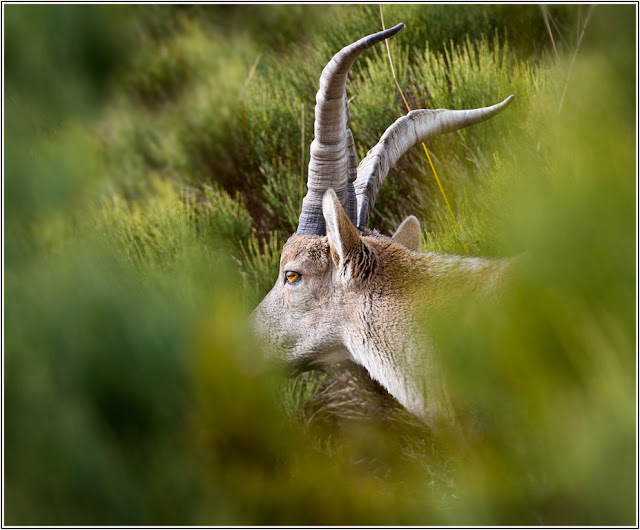One of the first ones to land at dawn
D3s, 600 4,0, f4,0, 1/50, ISO 6400
The Spanish Pyrenèes hold some magnificent untouched natural wildernesses, and being here for the first time, I was really amazed. Photographer Dario Mesonero Romanos took us to a remote place called Torre de Tamurcia, and here we had 2 full days / nights in a small hide for Iberian vultures. In this specific hide we had to shoot through glass, so called "one way glass" (which was not at all as "one way" as we thought). The glass of course takes away a considerable amount of available light for the camera and I as also concerned about sharpness shooting through glass. The sharpness however, performed without problems. We had to our disposal 5 full barrels of sheep intestines / slaughter leftovers, and we carefully portioned 2 of these for the first day. The griffons (gåsegribben) appeared early next morning at dawn, and I honestly nearly panicked when the windows in the hide (due to difference in outside / inside temp) suddenly went milky white with condensation !! In this situation I had no choice : I had to try to wipe it carefully off in front of the lens ....and the consequence was disastrous : the vultures all took off together...and never returned that day.
The following night we polished windows with any-condensation polish (!!) and poured out the remaining 3 barrels of smelly carcass. This was in my eyes a considerable amount of "bird-food", and, unexperienced as I am with vultures, I expected this to last for hours the next day.
Early next morning we first saw 1, then 2, then 5, then 8 vultures in the air.... and suddenly, out of nowhere, they all came down as on a signal,...in incredible numbers !! I estimated the numbers of griffons to be approx 4 - 500 !!!....and they literally "rolled over" the carcass like a living "consuming carpet"!! The meat was basically gone in 10 minutes. I was amazed !!
We had no condensation problems this morning, and the griffons stayed with us for almost 3 hours... before they all took off together and simply dispersed into the vast Pyenèe landscape.
Ugly ? Well, in our human eyes ...with their bare heads and necks and very special preferences for food ... maybe, ...but also beautiful. In fact very beautiful !! They perform like sailships in the air with wingspan close to 3 m and on close range they reveal beautiful colors with a clean white "ostrich-scarf" around the neck and intelligent, sharp eyes. And besides : anyone who have seen the cartoon movies "The Jungle Book" and "Robin Hood" with the soldiers of Nottingham, ...must have some kind of a relation to vultures !!!
Ugly ? Well, in our human eyes ...with their bare heads and necks and very special preferences for food ... maybe, ...but also beautiful. In fact very beautiful !! They perform like sailships in the air with wingspan close to 3 m and on close range they reveal beautiful colors with a clean white "ostrich-scarf" around the neck and intelligent, sharp eyes. And besides : anyone who have seen the cartoon movies "The Jungle Book" and "Robin Hood" with the soldiers of Nottingham, ...must have some kind of a relation to vultures !!!
It took them approx 10 minutes to finish 3 barrels of carcass !!
D3s, 600 4,0, f4,0, 1/125, +0,67, ISO 6400
D3s, 600 4,0, f4,0, 1/100, +0,67, ISO 5000
D3s, 600 4,0, 1/80, +0,33, ISO 5000
D3s, 600 4,0, f4,0, 1/100, ISO 6400
Portrait of griffon vulture
D3s, 600 4,0, f4,0, 1/250, ISO 6400
Portrait of griffon vulture
D3s, 600 4,0, f4,0, 1/200, ISO 6400
Portrait of griffon vulture
D3s, 600 4,0, f4,0, 1/400, ISO3200
Portrait of griffon vulture
D3s, 600 4,0, f4,0, 1/200, ISO 3200
Portrait of griffon vulture
D3s, 600 4,0, f4,0, 1/250, ISO 1600
Portrait of griffon vulture
D3s, 600 4,0, f4,0, 1/200, ISO 1600
Portrait of griffon vulture
D3s, 600 4,0, f4,0, 1/200, ISO 1600
Portrait of griffon vulture
D3s, 600 4,0, f4,0, 1/200, ISO 1600
D3s, 600 4,0, f4,0, 1/320, ISO 1600
With wingspan close to 3 meters... this is a huge bird !
D3s, 600 4,0, f5,6, 1/1250, +0,67, ISO 500
D3s, 600 4,0, f5,6, 1/2000, +0,33, ISO 1600
D3s, 600 4,0, f5,6, 1/2500, +0,33, ISO 1600
Pyrenèe landscape
D3s, 70-200 2,8 / 70, f6,3, 1/1000, -0,67, ISO 200
*
I got more stuff from the Pyrenèes coming up !!
































